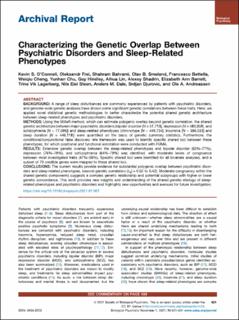Characterizing the Genetic Overlap Between Psychiatric Disorders and Sleep-Related Phenotypes
O'Connell, Kevin Sean; Frei, Oleksandr; Bahrami, Shahram; Smeland, Olav Bjerkehagen; Bettella, Francesco; Cheng, Weiqiu; Chu, Yunhan; Hindley, Guy; Lin, Aihua; Shadrin, Alexey; Barrett, Elizabeth Ann; Lagerberg, Trine Vik; Steen, Nils Eiel; Dale, Anders M.; Djurovic, Srdjan; Andreassen, Ole A.
Journal article, Peer reviewed
Published version

Åpne
Permanent lenke
https://hdl.handle.net/11250/2988220Utgivelsesdato
2021Metadata
Vis full innførselSamlinger
- Department of Clinical Science [2318]
- Registrations from Cristin [9791]
Sammendrag
Background: A range of sleep disturbances are commonly experienced by patients with psychiatric disorders, and genome-wide genetic analyses have shown some significant genetic correlations between these traits. Here, we applied novel statistical genetic methodologies to better characterize the potential shared genetic architecture between sleep-related phenotypes and psychiatric disorders.
Methods: Using the MiXeR method, which can estimate polygenic overlap beyond genetic correlation, the shared genetic architecture between major psychiatric disorders (bipolar disorder [N = 51,710], depression [N = 480,359], and schizophrenia [N = 77,096]) and sleep-related phenotypes (chronotype [N = 449,734], insomnia [N = 386,533] and sleep duration [N = 446,118]) were quantified on the basis of genetic summary statistics. Furthermore, the conditional/conjunctional false discovery rate framework was used to identify specific shared loci between these phenotypes, for which positional and functional annotation were conducted with FUMA.
Results: Extensive genetic overlap between the sleep-related phenotypes and bipolar disorder (63%–77%), depression (76%–79%), and schizophrenia (64%–79%) was identified, with moderate levels of congruence between most investigated traits (47%–58%). Specific shared loci were identified for all bivariate analyses, and a subset of 70 credible genes were mapped to these shared loci.
Conclusions: The current results provide evidence for substantial polygenic overlap between psychiatric disorders and sleep-related phenotypes, beyond genetic correlation (|rg| = 0.02 to 0.42). Moderate congruency within the shared genetic components suggests a complex genetic relationship and potential subgroups with higher or lower genetic concordance. This work provides new insights and understanding of the shared genetic etiology of sleep-related phenotypes and psychiatric disorders and highlights new opportunities and avenues for future investigation.
